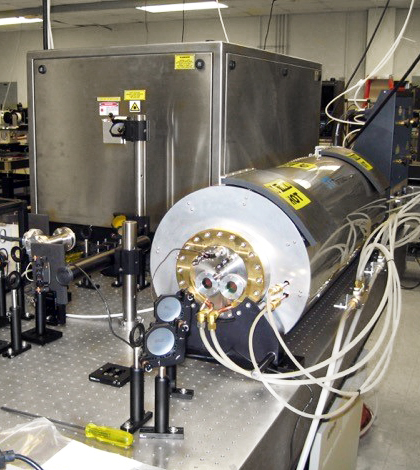U.S. Army’s eight-foot laser detects gases at a distance

The problem with toxic gas is that if you’re close enough to know it’s there, you’re probably already in trouble. Researchers from Ohio State University, Duke University and the U.S. Army investigated the use of a custom laser that can help identify harmful gases at a safe distance. They published their findings online in Physical Review Applied.
Armed with a terahertz source and their custom infrared laser, the researchers used a technique known as double resonance spectroscopy to pick up the chemical signature of a gas cloud at a distance. According to Henry Everitt, chief scientist for the U.S. Army Aviation and Missile Research, Development and Engineering Center, the technique is “well-known in the optics and spectroscopy community,” but has never before been applied to remote sensing.
Terahertz sources, emitting beams that exist between microwaves and infrared radiation, have been around since the 1970s, Everitt says. When fired at trace gases — at the right frequency — the beam forces molecules to adopt different rotational states, creating a spectral signature of sorts. But the devices have seen minimal use outside of the lab or the reaches of space, where atmospheric pressure and moisture can render the signature unreadable.
“They’re fairly inefficient,” Everitt said. “One of the most frustrating things about them is that it takes a very specific pump frequency to excite a specific gas.”
As it turns out, that limitation was a blessing in disguise.
“If you flip that problem around, it becomes an advantage,” Everitt said. When calibrated to a particular wavelength, the terahertz source can accurately detect the gases in that wavelength. “It was kind of making lemonade out of lemons.”
Even with that approach, the terahertz source still suffers from issues in normal atmospheric conditions. That’s where the double resonance spectroscopy comes in.
“If you can use a second beam, you can cause the gas to emit or absorb light in a manner that you can control,” Everitt said. “It’s kind of like hitting the molecule with a hammer.”
That second beam emanates from an eight-foot-long, one-ton infrared laser currently installed at AMRDEC near Huntsville, Alabama. The laser can fire infrared light in dozens of pulses per second, which help modulate the absorption spectrum of a molecule. This produces a characteristic “flicker” that can be identified by the terahertz source.
The new technique could be used for an array of applications, Everitt said. For instance, the lasers could be placed around a military installation as a sort of chemical tripwire, alerting soldiers of incoming gas attacks. Firefighters could determine if toxic chemicals are present before entering a building. And law enforcement agents might use the technique to spot hidden drug manufacturing facilities or identify pollutants coming from factory smokestacks.
For now, Everitt says the size of the laser is no issue; in the lab they can build their experiments around the device. But for use in any of the aforementioned applications, the device would need to fit in the back of a truck.
The researchers have only tested the laser on three different chemicals: methyl fluoride, methyl chloride and methyl bromide gases. But the research is ongoing, and Everitt says they hope to identify the spectra of the more “interesting gases” as investments permit.
“We only have a few molecules in our library right now,” Everitt said. “The only thing standing between us and a complete library is time and money.”
“Right now, that’s the difference between this being a clever idea and it becoming a practical idea,” he said.
Top image: The U.S. Army’s new gas-detecting laser. (Credit: Henry Everett, U.S. Army and Duke University)





0 comments